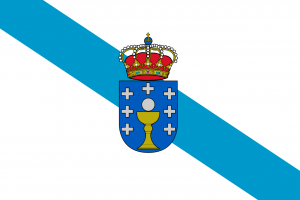Language/Galician/Grammar/Descriptive-Adjectives
| ◀️ Common Drinks — Previous Lesson | Next Lesson — Adjective Agreement ▶️ |
Galician adjectives are words that modify nouns or pronouns, giving more information about them, such as their size, color, or shape.
In this lesson, you will learn how to use descriptive adjectives in Galician to describe nouns. You will also learn how they must agree with the nouns they describe in gender and number.
Descriptive Adjectives
Descriptive adjectives describe the characteristics of nouns or pronouns. They provide more information about the person, object, or animal they modify. For example:
- Un gato negro: A black cat
- Unha mesa grande: A big table
- Unhas flores bonitas: Some beautiful flowers
In these examples, "negro", "grande", and "bonitas" are adjectives that add more details about the noun.
Descriptive adjectives always agree with the noun they describe in gender and number. This means that if the noun is feminine, the adjective must also be feminine, and if the noun is plural, the adjective must also be plural. For example:
- Unha casa branca (feminine and singular): A white house
- Unhas casas brancas (feminine and plural): Some white houses
- Un home alto (masculine and singular): A tall man
- Uns homes altos (masculine and plural): Some tall men
Notice how in the feminine form the adjective takes an "a" at the end, while in the masculine form it doesn't. In the plural form, both masculine and feminine adjectives take an "s" at the end.
Here are some other examples of descriptive adjectives:
| Galician | Pronunciation | English |
|---|---|---|
| Alto/a | ['al.tɔ] | Tall |
| Baixo/a | ['baj.ʃɔ] | Short |
| Novo/a | ['nɔ.vɔ] | New |
| Vello/a | ['be.ʎɔ] | Old |
| Bo/a | ['bɔ] | Good |
| Malo/a | ['ma.lɔ] | Bad |
| Bon / Boa | ['bɔŋ] / ['bɔ.ɐ] | Beautiful / Good |
| Feo/a | ['fe.ɔ] | Ugly |
| Delgado/a | [dɛl'ɣa.ðɔ] | Thin |
| Gordo/a | ['ɡɔr.ðɔ] | Fat |
Note that the adjectives "bon" (masculine) and "boa" (feminine) can be translated as either "beautiful" or "good", depending on the context.
Adjective Agreement
As mentioned earlier, descriptive adjectives must agree with the noun they describe in gender and number. This means that the ending of the adjective will change depending on the gender and number of the noun. Here's a quick summary:
- Masculine and singular: no ending
- Feminine and singular: -a
- Masculine and plural: -os
- Feminine and plural: -as
To use the correct form of an adjective, you need to identify the gender and number of the noun it's describing. for example:
- Un can pequeno (a small dog): "pequeno" agrees with "can" (masculine and singular).
- Unha gata pequena (a small cat): "pequena" agrees with "gata" (feminine and singular).
- Un neno alto (a tall boy): "alto" agrees with "neno" (masculine and singular).
- Unhas rapazas altas (some tall girls): "altas" agrees with "rapazas" (feminine and plural).
Remember also that the adjective comes after the noun in Galician. This is different from English, where the adjective usually comes before the noun.
Practice
Now it's time to practice using descriptive adjectives in Galician!
- Translate the following sentences into Galician, using the correct form of the adjective:
1. The old man: 2. The new car: 3. A big house: 4. Some small dogs: 5. The beautiful flowers:
- Translate the following sentences from Galician to English:
6. Unha mesa branca: 7. Unha muller bonita: 8. Un vestido azul: 9. Uns homes feos: 10. Un gato negro:
Conclusion
Descriptive adjectives are important in Galician if you want to be able to describe people, objects, and animals accurately. Remember that they must always agree with the noun they're describing in gender and number.
In this lesson, you have learned how to form descriptive adjectives in Galician, and how to use them correctly in sentences. With practice, you will become more confident in using adjectives and be able to describe things more precisely.
Don't forget to practice by using Galician in your daily life, and try to use descriptive adjectives as much as you can!
Other Lessons
- Future Tense
- Imperative Tense
- Definite Articles in Galician
- Plurals
- Prepositional Phrases
- Adjective Agreement
- Past Tense
- Definite and Indefinite Articles
- Adverbs in Galician
Sources
| ◀️ Common Drinks — Previous Lesson | Next Lesson — Adjective Agreement ▶️ |

